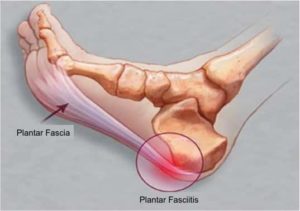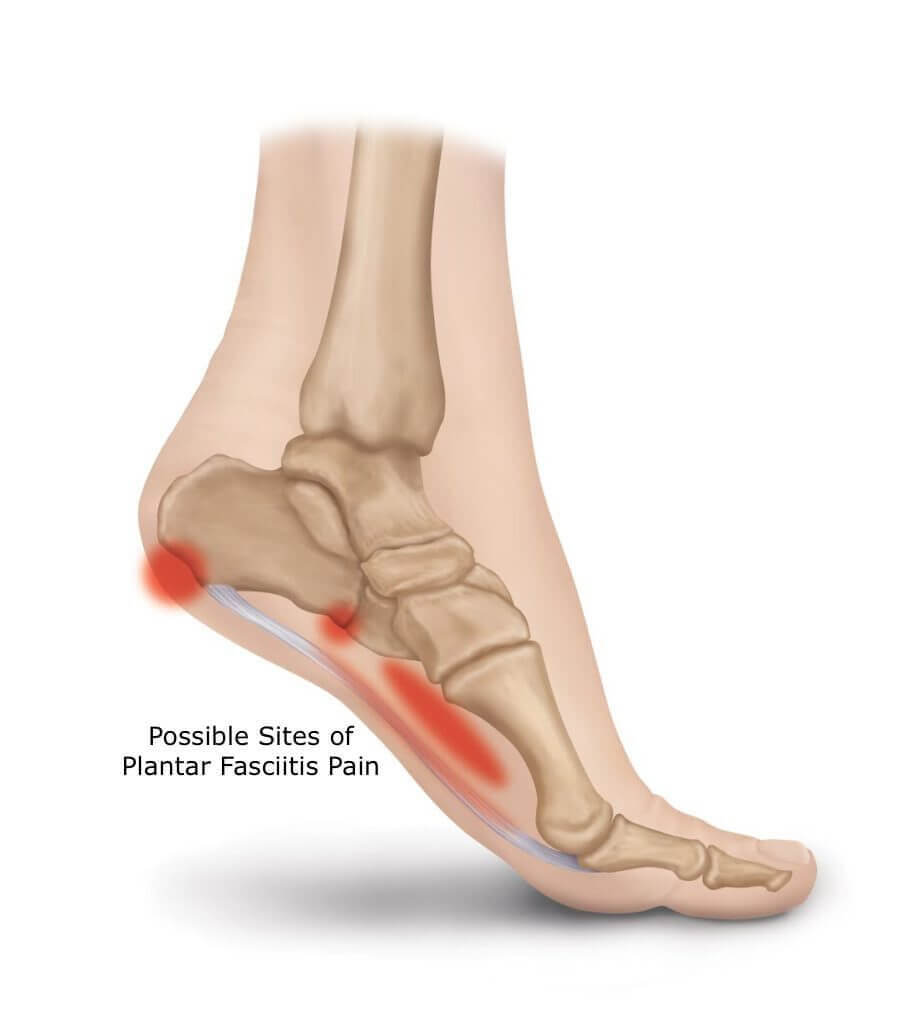
Let’s Talk!
We’re here to help you with any questions you may have. Please don’t hesitate to reach out to us.
Plantar Fasciitis is one of the most common causes of foot pain. It is an inflammatory condition of the plantar fascia, a ligament that connects the inside of the heel bone to the toes. The plantar fascia is responsible for supporting the arch on the underside of the foot and absorbing some of the load we place on our foot while we stand or walk. Plantar Fasciitis usually develops when the plantar fascia is stretched beyond its normal range or sprained, causing small tears and inflammation. Plantar fasciitis is a relatively common injury among runners. It is also common among individuals whose jobs require standing for long periods of time.

With early intervention, the treatment for Plantar Fasciitis is fairly straightforward. But if you ignore its symptoms, it is likely that the injury and inflammation will aggravate and that the treatment will become more arduous.
Inflammation of the plantar fascia causes swelling, tenderness and pain at the base of the foot. Pain develops gradually and is usually felt as a constant, dull ache at the bottom of the heel. Plantar fasciitis pain is usually worse when you get out of bed in the morning or during the first steps after sitting for a long period of time. While you are standing or walking, you may sometimes feel a sharp, stabbing pain in the heel.
Pain associated with Plantar Fasciitis can easily disturb your regular physical activities and even your normal daily activity. If you recognize any of these symptoms, you should seek immediate treatment or you risk aggravating your injury.
With the aid of conservative treatment, the body usually repairs small plantar fascia tears naturally. Therefore, it can be easy to control the inflammatory process and even reverse the damage to the plantar fascia.
The vast majority of cases of plantar fasciitis resolve within a few months. Conservative treatments include rest, stretching, ice massage, deep massage or wearing night splints or custom orthotics to provide foot support.
Ignoring plantar fasciitis can make it worse. With repeated stress, the small tears in the plantar fascia can accumulate and affect the strength and stability of the ligament. If left untreated, the process of tearing makes it more vulnerable to further damage. This sets off a snowball effect that leads to degeneration and persistent inflammation.
The longer you delay treatment, the less likely you are to improve from conservative management. As you continue to overload the ligament, the injury and inflammation continue to develop and all the symptoms of Plantar Fasciitis become more severe. If your Plantar Fasciitis becomes too serious, you may require surgical treatment.
Most people ignore the symptoms of Plantar Fasciitis until it begins to clearly affect their ability to maintain their day-to-day activities and their quality of life. As a consequence, by the time they seek treatment, many patients with untreated Plantar Fasciitis have already developed severe disability.

As Plantar Fasciitis worsens, heel pain in the morning becomes more intense and lasts longer. You may also start to feel sharp pain during the first few steps after sitting even for short periods of time. You may even feel throbbing or stabbing pain during periods of rest. Therefore, in the absence of interventions to control or minimize Plantar Fasciitis, you may reach a point where you feel pain all day.
Even if you abstain from exercise, there is still load and stress on your feet while you stand or walk. This can worsen the damage to the ligament and even lead to plantar fascia tears. Untreated Plantar Fasciitis may result in constant severe heel pain that interferes with your regular activities and that can last for years. If
you do not treat your Plantar Fasciitis, permanent disability may even occur.
Damage to the plantar fascia increases the effort of walking and weight bearing. As a consequence, you may unconsciously change your posture and the way you walk to minimize pain. This may affect the biomechanical characteristics of the feet, as well as of the knees, hip, and even your back. As a consequence, it may cause foot, knee, hip or back problems, such as heel spurs, ligament tears, ankle pain, knee pain and osteoarthritis, hip pain and osteoarthritis, back discomfort, pelvic instability, etc.
The earlier you seek treatment for Plantar Fasciitis and take appropriate measures, the easier it will be to resolve your heel pain. With the appropriate conservative management, it is likely your Plantar Fasciitis will be resolved within a few months.
With rest, ice, stretching, massage and foot support, your body will begin to gradually repair the injury to the plantar fascia and inflammation will start to subside. Within a few weeks, you will notice that the heel has become less swollen and that pain has become less severe and less frequent. You will start to be able to sit for longer periods of time without feeling that sharp heel pain during the first steps after you stand up. With time, you will stop feeling heel pain when you get out of bed in the morning.
For appointments and enquires:
Phone: (774) 421-9144
This information is for educational purposes only and is NOT intended to replace the care or advice given by your physician. Always seek the advice of your physician or other qualified health provider before starting any new treatment or with any questions you may have regarding a medical condition. For more information see our Medical Disclaimer.
– Privacy Policy – Terms of Use –
Copyright 2023 © The Center for Morton’s Neuroma. All Rights Reserved.

We’re here to help you with any questions you may have. Please don’t hesitate to reach out to us.
The Center for Morton's Neuroma
